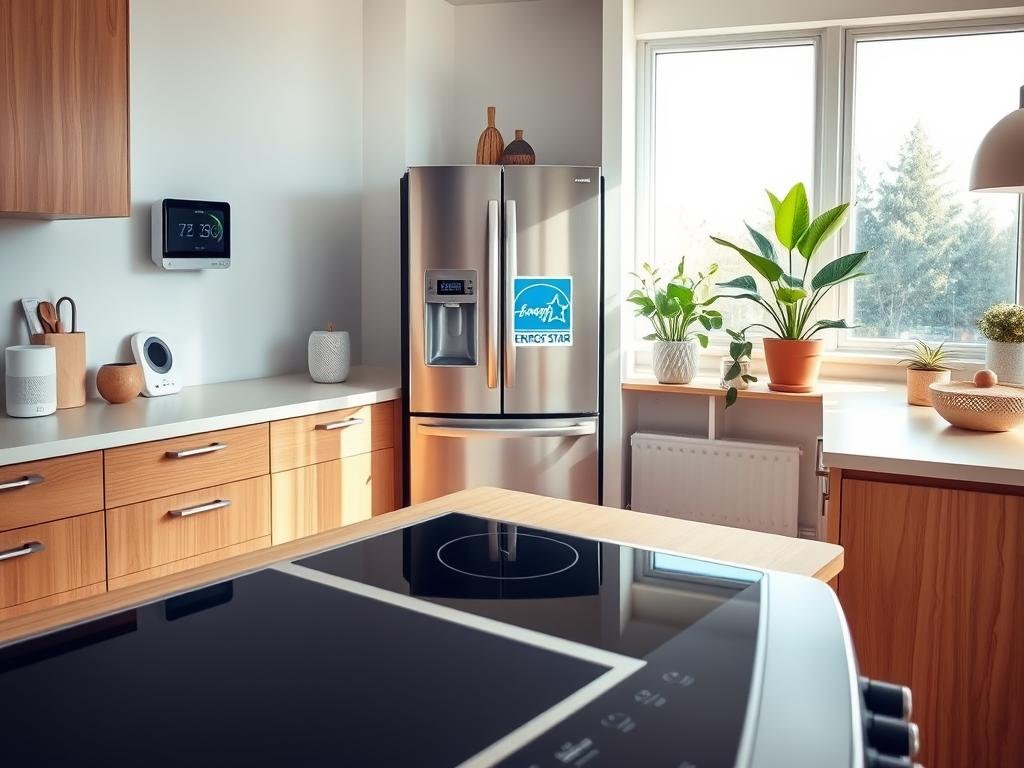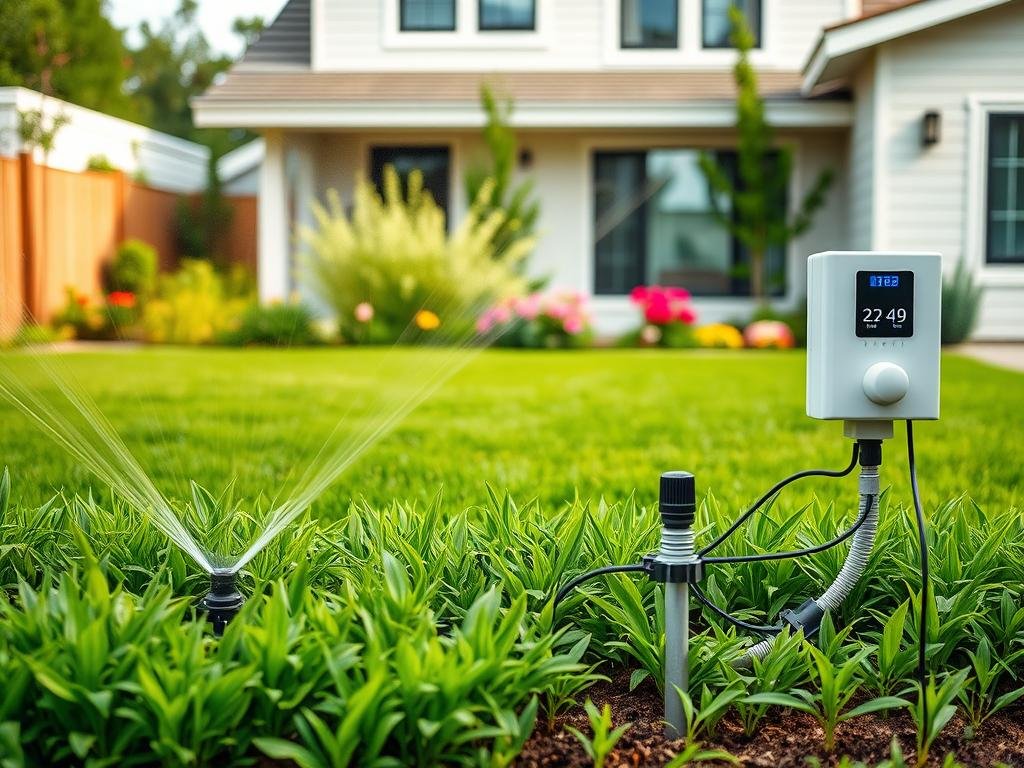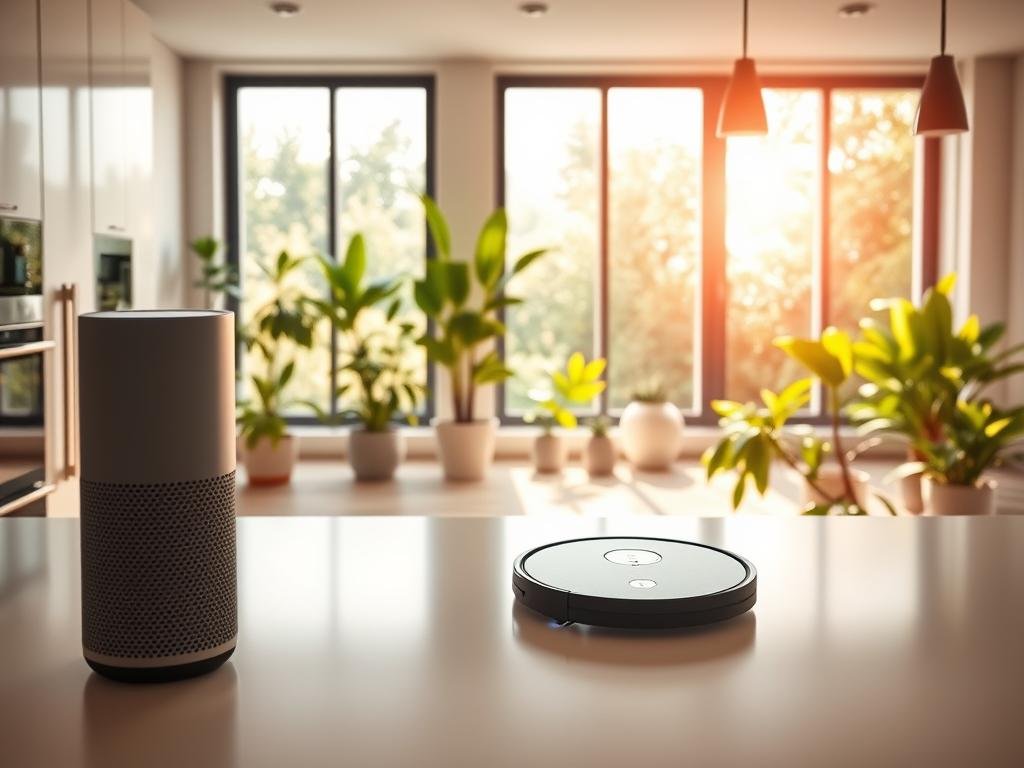Homes use a lot of energy, making up a big part of our energy use. But, with new eco-friendly tech, you can make your home greener. This tech helps you use less energy.
Eco-friendly tech is changing how we live, helping us use less energy. By using solutions that save energy, you help the planet. This makes our future more sustainable.
Using energy-efficient devices can cut your energy bills. It also helps save natural resources. As a homeowner, you can really make a difference for the environment.
1. Introduction to Smart Home Devices
Entering the world of smart home technology opens up a world of innovation. These devices aim to make your home more energy-efficient and sustainable. They change how you live, work, and interact with your home.
What Are Smart Home Devices?
Smart home devices can be controlled and monitored through your phone, tablet, or computer. They have sensors, Wi-Fi, and smart software. This lets them learn your habits and adjust on their own. Examples include smart thermostats, lights, security cameras, and entertainment systems.
Adding these devices to your home brings more convenience, safety, and energy savings. For example, smart thermostats adjust the temperature based on your preferences. Smart lights turn off when you leave a room.
Benefits of Smart Technology for Sustainability
Smart home technology offers more than just convenience. It also boosts sustainability by saving energy and reducing waste. These devices help make your home more eco-friendly.
Key benefits include:
- Energy efficiency through smart heating, cooling, and lighting
- Less energy waste by turning off unused devices
- Better control over your energy use
- Support for eco-friendly habits through automation
When looking at top smart home gadgets and reading smart home technology reviews, think about their impact on your home’s sustainability. The right devices can make your home more eco-friendly.
2. Energy-Efficient Smart Thermostats
Smart thermostats are changing how we manage home energy. They learn your habits and adjust the temperature for you. This makes your home more comfortable and saves energy, which lowers your bills.
Devices like Google Nest can save you up to 12% on heating and 15% on cooling.
Top Brands to Consider
Many brands are leading in smart thermostats. Here are some top ones:
- Google Nest
- Ecobee
- Honeywell Home
For more details, check out PCMag’s smart thermostat reviews. They offer insights into the latest models and their features.
Key Features That Matter
When picking a smart thermostat, look for these key features:
| Feature | Description | Benefit |
|---|---|---|
| Learning Capability | Ability to learn your schedule and preferences | Automated energy savings |
| Geofencing | Adjusts temperature based on your location | Enhanced energy efficiency |
| Smart Home Integration | Compatibility with other smart home devices | Seamless home automation |
Experts say smart thermostats are key in smart homes. They offer convenience, comfort, and save energy. For more on smart thermostats, check out Digital Vista Online.
Choosing the right smart thermostat can greatly reduce your energy use. It helps make your home more eco-friendly.
3. Smart Lighting Solutions
Smart lighting is changing how we use energy at home. It lets you control lights from anywhere or on a schedule. This can cut down your energy use a lot. LED smart bulbs are great because they save energy and are flexible.
Benefits of LED Smart Bulbs
LED smart bulbs use up to six times less energy than old bulbs. They save energy and let you change color and brightness. This can make your home look better and help your body clock by mimicking daylight.
You can set your bulbs to get brighter in the morning or dimmer at night. This helps you wake up or relax. You can find the latest smart home devices, like LED bulbs, on review sites. They help you pick the best for your home.
Energy Management with Smart Lighting
Smart lighting fits into your energy-saving plan. It turns off lights when not needed, saving energy. It also works with other smart devices to use energy better.
Your lights can turn off when you leave or when your security system is on. This saves energy and makes your home safer and more convenient.
4. Eco-Friendly Appliances
Adding eco-friendly appliances to your smart home is a big step towards saving energy and being green. These devices use less energy and water, helping to lower your environmental impact.
Choosing Energy Star-Rated Devices
It’s important to pick appliances that are Energy Star-rated. The Energy Star program shows which products are energy-efficient. Choosing these devices means you’re getting top-notch energy use and performance.
For more on eco-friendly smart home devices, visit NetZero India.
Energy Star appliances save energy, cut down on bills, and are better for the planet. Look for features like better insulation, smart sensors, and efficient motors.

Smart Refrigerators and Their Features
Smart refrigerators are changing how we use our kitchens. They have cool features like smart sensors, automatic inventory tracking, and energy-saving cooling. For example, some can adjust their temperature based on what’s inside and how often you use it.
Smart refrigerators have some great features:
- They manage energy well to save you money
- Smart sensors keep the fridge at the right temperature
- They help you track your groceries and cut down on waste
Adding smart refrigerators and other eco-friendly appliances to your home makes it more green and efficient. For more on smart home tech, see Digital Vista Online.
5. Smart Home Energy Monitors
Installing a smart home energy monitor can greatly reduce energy waste. These devices track your energy use in real-time. They give you insights into how much you consume.
How They Work
Smart home energy monitors connect to your home’s electrical panel or specific appliances. They send data to a central hub or your smartphone. This lets you see your energy use from anywhere.
Popular Models and Their Benefits
Models like the Sense Energy Monitor and the Neurio Home Energy Monitor are popular. They offer real-time energy data, automated tracking, and tips to save energy.
| Model | Key Features | Benefits |
|---|---|---|
| Sense Energy Monitor | Real-time energy tracking, automated device detection | Detailed energy usage insights, easy installation |
| Neurio Home Energy Monitor | Whole-home energy monitoring, real-time data | Identifies energy-hungry appliances, provides energy-saving tips |
For more on smart homes, including budget-friendly gadgets and tips, check out our article on Building a Smart Home on a budget.
6. The Role of Smart Plugs
Smart plugs can turn your home into a smart home. They let you control any plugged-in appliance from afar. This makes managing your energy use easy.
Energy Savings with Smart Plugs
Smart plugs make any electrical device smarter. They help reduce idle power usage and lower your bills. For example, you can set your coffee maker to turn off after brewing.
They also help you turn off devices when not in use. This saves energy and money.
Smart plugs also let you monitor your devices’ energy use. This shows which appliances use the most energy. It helps you decide how to use them better.
Top Picks on the Market
Looking for smart plugs? Check out these top-rated options. Websites like CNET and Digital Vista Online have comparisons and reviews. They help you understand the features and benefits of different models.
When picking a smart plug, think about a few things. Look for compatibility with your smart home system. Also, check if it has energy monitoring and is easy to use. The right smart plug can make your home more energy-efficient and help the environment.
7. Home Automation for Energy Efficiency
Integrating smart devices can make your home more energy-efficient. Home automation helps save energy by using resources like electricity and water wisely. It uses a centralized system to manage all smart devices, ensuring your home runs smoothly.
Creating Automated Energy-Saving Routines
Automated routines can cut down your energy use a lot. For example, you can set your smart thermostat to change the temperature when you’re away or asleep. The U.S. Department of Energy says this can save up to $150 a year on bills.
“The key to saving energy is through automation,” says
John Smith, a smart home expert
. “By automating lights, heating, and cooling, you can avoid wasting energy.”
Integrating Devices for Maximum Impact
It’s important to connect different smart devices for the best results. For instance, linking smart lighting with your smart home hub can turn off lights when you leave a room. When picking devices, look at smart home device ratings and use a smart home device comparison chart to choose wisely.
- Enhanced energy efficiency
- Increased convenience
- Improved home security
By creating a unified system, you can have a greener and more efficient home. As smart home tech gets better, so will your energy savings.
8. Landscaping with Smart Technology
You can take your eco-friendly efforts to the next level by adding smart technology to your landscaping. This makes your outdoor space more beautiful and helps the environment.
Smart Irrigation Systems
Smart irrigation systems are key in smart landscaping. They have sensors that check soil moisture, weather, and plant needs. This helps you water just right, saving water and keeping plants healthy.
Some benefits of smart irrigation systems are:
- Water conservation: They help you use less water.
- Reduced maintenance: They automate watering, saving you time.
- Improved plant health: They ensure plants get the right water, making them healthier.

Eco-Friendly Landscaping Techniques
There are also eco-friendly landscaping methods to boost sustainability. These include:
- Using native plants that need less water and care.
- Adding rainwater harvesting systems to reuse rainwater.
- Using mulch to prevent soil erosion and keep moisture.
By mixing smart irrigation with these techniques, you can make a stunning, green outdoor space. When picking the latest smart home devices for landscaping, use a smart home device buying guide to choose wisely.
9. Future Trends in Eco-Friendly Smart Devices
New technologies are changing the smart home world, making it greener and using less energy. When you think about adding smart devices to your home, it’s key to know what’s coming next.
Innovations on the Horizon
AI and 5G connectivity are going to change the smart home world a lot. These will help devices talk better to each other, making your home smarter and more ready for you. For example, AI can learn your habits and adjust energy use, saving you money and the planet.
Another big change is using renewable energy in smart homes. This means solar panels and systems to store energy, so you use less from the grid. CNET says we’ll see more of this, making homes greener.
How These Trends Affect Sustainability
New trends in smart devices will really help the planet. With AI, 5G, and green energy, homes will use less power and pollute less. For instance, smart thermostats can adjust based on when you’re home, and lights can change color with the day.
Looking into these new techs? Check out Digital Vista Online for the latest on gadgets. By using these new tools, you’ll make your home greener and help the planet too.
10. How to Get Started with Smart Home Technology
To start your smart home journey, think about what you want to save energy on. There are many devices to choose from, making it hard to pick the right one. Check out top-rated smart home gadgets to find what suits you best.
Device Selection Tips
When picking smart home devices, think about how well they work together. Look for devices that save energy, like smart thermostats and lights. Brands like Amazon, Google, and Apple have many gadgets that can help you save energy.
Planning for Long-Term Savings
To get the most out of your smart home devices, plan for long-term savings. Set up routines that save energy and make sure devices work well together. For tips on building a smart home, visit Digital Vista Online.
FAQ
What are the benefits of using smart home devices for sustainability?
Smart home devices can cut down on energy use. They encourage green living and boost energy efficiency. This makes for a greener home.
How do energy-efficient smart thermostats work?
Energy-efficient smart thermostats learn your temperature likes. They adjust the heat or cool to save energy. This cuts down on waste.
What are the advantages of using LED smart bulbs for lighting?
LED smart bulbs use less energy and last longer. They also let you change colors and brightness. This makes them great for smart lighting.
How can I choose the right eco-friendly appliances for my home?
Look for Energy Star-rated devices. Check the energy use and features of smart appliances. Smart refrigerators are a good example for a green home.
What is the role of smart home energy monitors in reducing energy waste?
Smart home energy monitors track energy use in real-time. They help spot where energy is wasted. This lets you make smart choices to save energy.
How can smart plugs contribute to energy savings?
Smart plugs control and monitor device energy use. They let you turn off devices when not in use. This boosts energy efficiency.
What are the benefits of home automation for energy efficiency?
Home automation lets you set up energy-saving routines. It integrates devices for better efficiency. This reduces energy use.
How can smart irrigation systems contribute to water conservation?
Smart irrigation systems adjust watering based on weather and soil. They save water by avoiding waste. This helps conserve water.
What are the future trends in eco-friendly smart devices?
Future trends include AI, IoT, and energy-harvesting tech. These advancements will improve energy efficiency and reduce harm to the environment.
How do I get started with smart home technology for energy savings?
First, check your energy use. Then, pick the right devices. Plan for long-term savings to make smart choices for your home.
What are the best smart home devices for energy efficiency?
Top devices include Nest and Ecobee thermostats, Philips Hue bulbs, and Sense and Neurio monitors. They’re all energy-efficient.
How can I compare different smart home devices?
Compare features, energy efficiency, compatibility, and prices. This helps you find the best device for your needs and budget.
